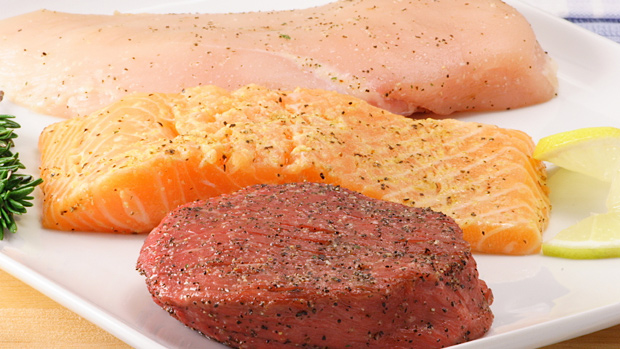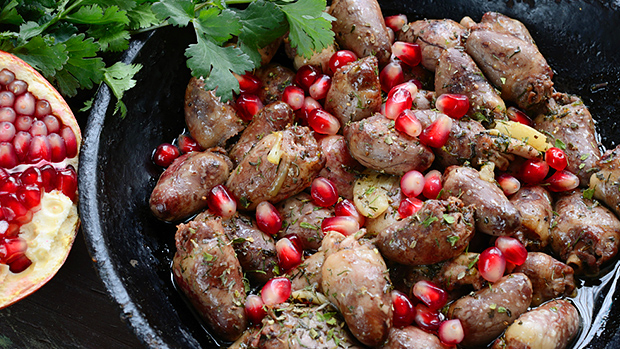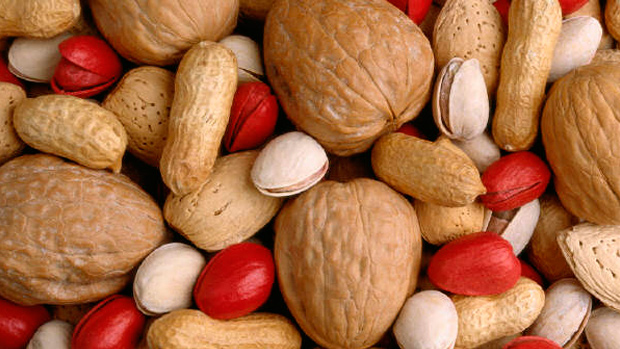The Law of the Land
Long ago, when I first began to pay serious attention to my training and nutrition, I learned of a general principle that has served me well and has since become the cornerstone of my body composition success.
If a food is in your possession or located in your residence, you will eventually eat it.
Corollary to Berardi's First Law
If you wish to be healthy and lean, you must remove all foods not conducive to those goals from said residence and replace them with a variety of better, healthier choices.
Second Corollary to Berardi's First Law
If you know someone whose house is stocked only with optimal food choices and yet who is not healthy and lean, look under his bed.
The bottom line is that you must stock your house with all the ammo you need to fight the battle of the bulge. My body fat ranges from about 5% to about 8% throughout the year (without the use of thermogenics) and the only way I'm able to maintain that level of leanness is by removing all temptation from my home, where I spend most of my time.
For years I've advised my clients and athletes to do the same. Now I bring the message to you. Your willpower and discipline will be tested enough at social events, at lunch meetings, and as you pass the six Krispy Kreme locations on the commute home from work. If you're to have any chance of success, you need a safe home base.
With that in mind, I'm going to give you a peak into my armory . . . er, kitchen. In this week's installment, I'll open my stainless steel fridge to show you what and what not to stock. In doing so I hope to demonstrate that there are plenty of options available to the trainee interested in optimal health and body composition. Of course, this is not intended to be a comprehensive list in any way; rather, it's a snapshot of the actual contents of my favorite appliance, and as such should serve as a practical example of the nutrition theory I expound elsewhere on this site.
Let's begin, shall we?
I must get at least a dozen emails a day by readers who complain that they're tired of eating beef. I don't dignify those emails with a response. Word to the wise: if you want free nutrition advice from me, don't disparage Mr. Beef.
In all seriousness, you don't have to rely solely on beef for your protein intake – I certainly don't. I get a wide variety of meat, poultry and fish, some examples of which are listed below.
I'm lucky enough to have two excellent markets near my home and I realize that the more exotic selections listed below may be difficult for you to find. However, don't just assume because it's not at your local Piggly Wiggly, you can't get it. Look around for nearby farmer's markets, or make a trip out to a more distant one and freeze your purchases.
Alternatively, you might want to try one of the various online distributors. I can't recommend these as I've never tried them myself, but if you've had some success with them, drop me a line at and let me know so I can spread the word.
So let's see what types and quantities of goodies are stashed in my fridge:
Extra Lean Ground Sirloin
- Quantity: 3 x 1lb packages
- Notes: I buy the leanest ground beef I can find, and I keep a couple pounds on hand. Most of the time this is purchased from the meat section in my favorite grocery store, but I'll sometimes go down to a local farmer's market to have grass-fed beef freshly ground for me.
Boneless Chicken Breasts
- Quantity: 2 x 1lb packages
- Notes: This too fluctuates. I buy the best chicken I can find, which most of the time is the grain-fed, store-bought type. I do buy free-range chicken whenever possible, but I won't skimp on the protein if I can't find the really good stuff (nor would I if I couldn't really afford to buy it).
Mild Turkey Sausage
- Quantity: 2 x 500g packages
- Notes: Turkey sausage is a great change of pace. I don't buy it all the time, but it goes quickly when I do. Who said you couldn't have street meat?
Ostrich
- Quantity: 2 lbs
- Notes: Fortunately, I'm able to get free-range ostrich meat at a nearby market and it's excellent. I either grill it as a filet or have it ground for me.
Bison (Buffalo)
- Quantity: 2 lbs
- Notes: Another great tasting meat. Bison steaks are truly amazing, and the macronutrient profile is excellent.
Elk
- Quantity: 2 lbs
- Notes: Elk meat tastes good, has a good macronutrient profile and always gets a great reaction when you surprise your dinner guest by revealing the identity of the food they're eating.
Salmon
- Quantity: 2 large filets
- Notes: Wild Atlantic salmon is perfect in pasta, in salads, or by itself. The genuine wild stuff has a great omega-3 profile, and cooked properly can go a long way toward impressing a date.
Eggs
I usually make one to two omelets a day so I keep a ton of eggs on hand. Note that my omelets don't have nearly the amount of cheese or butter one normally finds in them.
Here's what I use:
Omega-3 Eggs
- Quantity: 2 dozen
- Notes: Omega-3 eggs are laid by chickens that have been fed an omega-3 rich diet (10-20% ground flaxseed). I use one whole omega-3 egg in my morning omelet.
Egg Whites
- Quantity: 12 x 250mL cartons
- Notes: In addition to the whole omega-3 egg, I add 1 cup of egg whites to my morning omelet. (If you're interested, the other components are chopped veggies, spinach and – depending on my goals – a small amount of cheese.)
I'm lactose intolerant, yet I can still indulge in a little bit of cheese from time to time. During mass phases and maintenance phases, I use it judiciously. Of course, less is added during diet phases (unless I decide to rip out a couple of low carb weeks). However, dairy is often one of the first things I'll remove from a client's diet at the first sign of maldigestion, so you should pay close attention to your response to it. Most of the time I cut the cheese into small cubes and put it in salads, or into slices for my omelets, ground beef patties, and snacks.
Aged White Cheddar
- Quantity: 4-8 oz.
- Notes: Aged cheddar has a nice sharp taste to it, and a mouthfeel that's perfect for salads.
Baby Swiss
- Quantity: 4-8 oz.
- Notes: Mild nutty cheese that I occasionally add to my salads.
Havarti
- Quantity: 4-8 oz.
- Notes: One of my favorites for omelets.
Parmiggiano-Reggiano (Parmesan)
- Quantity: 4-8 oz.
- Notes: I usually grate some of this finely for pasta, the rest left whole or more coarsely grated for salads.
Feta Cheese
- Quantity: 4-8 oz.
- Notes: Once made from sheep or goat's milk, now commonly made with cow's milk. Perfect for salads with nuts and fruit, as the softer, crumbly mouthfeel complements the crispier ingredients.
Except for strict dieting phases, I always have some amount of fruit in my fridge. I constantly buy fresh seasonal fruit, whenever possible sticking to local organically grown produce. I keep all my fruit in the fridge, where it lasts longer. Furthermore, cold fruit is more refreshing and just tastes better.
Apples
- Quantity: 12
- Notes: I buy a half a dozen of two different varieties, Golden Delicious and Granny Smith. I'll cut them up and put them into salads or oatmeal, or eat them as snacks during mass phases.
Tangerines
- Quantity: 6
- Notes: I find tangerines easier to digest than oranges, and better tasting as well. I like to get at least some of my Vitamin C from whole food, and this is often how.
Red Grapes
- Quantity: Large bunch
- Notes: Another great salad ingredient, and an excellent snack. Grapes are also great to have around when guests are over.
Pineapple
- Quantity: 2 cut and cored fresh pineapples
- Notes: Pineapple is one of my favorite fruits, and rarely a week goes by when I don't buy one or two at the grocery store. Usually I'll cut it into small pieces and toss it in my oatmeal.
Strawberries
- Quantity: 2 cartons
- Notes: Who doesn't like strawberries? These also go in my oatmeal, a half-dozen or more at a time.
Blueberries
- Quantity: 2 cartons
- Notes: I love fresh blueberries. I put half a cup or more in my oatmeal and occasionally in my salads.
The problem with most diets is not that they don't get enough vegetables, but that they don't get any at all! You should familiarize yourself with the produce section of your local supermarket, or better yet, your local farmer's market. Pick up some fresh veggies and add them to every meal.
Spinach
- Quantity: 4 bags, 6oz. each
- Notes: Every salad I make, and I make a lot of them, begins with a base of spinach (see my article Covering Your Nutritional Bases for why). On top of that goes a selection of other vegetables, and depending on the time of day or my current body composition goals, cheese, chopped nuts, fruit, and a protein source (e.g., chicken or salmon) either in the salad or on the side. There are innumerable variations on this theme.
Peppers
- Quantity: 4
- Notes: I usually have two red peppers and two green peppers on hand. I'll usually quarter them or cut them into slices and store them in the fridge, adding them as necessary to salads, omelets and pasta.
Cucumbers
- Quantity: 2
- Notes: I'll have enough sliced cucumber on hand for one or two day's worth of salad. The rest is left whole.
Tomatoes
- Quantity: 2
- Notes: Organic tomatoes can be readily found, so I usually pick up a couple and add them to salads or, when I'm feeling ambitious, use them to make homemade tomato sauce.
Baby Carrots
- Quantity: 2 large bags, 2lbs each
- Notes: These go in virtually every salad I make, and I'll often snack on them between meals. I've heard some people talking smack about carrots as of late, but as long as they aren't the only vegetables in your diet, they're perfectly acceptable.
People always complain of being bored with the food on their nutrition plans. It lacks variety, they inevitably claim. To me, this has always been a spurious claim. For one, most people eat the same terrible foods day in and day out, so variety can't be the problem. Taste, on the other hand, may well be.
The foods outlined above taste different than the ones found in the average North American Diet – different, but certainly not worse. As I have said before, your palette is changeable, and what you enjoy now is mostly a matter of habituation. If variety is the problem, however, you should look into subtly changing the flavor of your meals with out substantially altering their content.
Pesto
- Quantity: 3 jars, one of each flavor
- Notes: I love pesto. It's extremely versatile, as its flavor lends itself to meat, fish, chicken, omelets, pasta and salads. I usually have the Basil, Sun-Dried Tomato and Black Olive flavors, and I'm constantly trying them with new foods. The Basil is my favorite. If possible, go for a brand that uses extra virgin olive oil as opposed to the other cheaper and inferior vegetable oils. You may have to go to an Italian deli or specialty grocer for that.
Peanut Satay Sauce
- Quantity: 1 bottle
- Notes: Awesome on beef and chicken. I love mixing some cubed beef or chicken, satay sauce and mixed vegetables in a bowl, and either eating it like that or doling the mix out into whole wheat tortillas. There are potential food allergy problems, but I haven't had issues with it.
Curry Sauce
- Quantity: 1 bottle
- Notes: Similar usage to the Satay Sauce. Curry sauce is an acquired taste for some, but is certainly useful to add variety.
Tomato Pasta Sauce
- Quantity: 2 large jars
- Notes: I use this on pasta, on meat and chicken, and on omelets. Generally, I'll have one or two jars of homemade sauce. As a God-fearing Italian-American, I can't possibly recommend the store-bought perversions.
Organic Apple Cider Vinegar
- Quantity: 1 bottle
- Notes: I buy the Omega Nutrition kind, and use it in most of my salads, most of which have fruit in them – the apple cider is really complementary for this.
Raspberry Vinegar
- Quantity: 1 bottle
- Notes: I use the raspberry vinegar to break up the monotony of the apple cider/fruit-containing salad combination.
Red Wine Vinegar
- Quantity: 1 bottle
- Notes: This is better in a more traditional Italian salad, which I have with more upscale meals, like the odd pasta or steak meal.
Balsamic Vinegar
- Quantity: 1 bottle
- Notes: Similar use to the red wine vinegar. This is a restaurant staple, and most people are familiar with it, which makes it nice to have when guests are over.
Flax Oil
- Quantity: 1 bottle
- Notes: I use plain flax oil either in shakes or straight from a spoon – both ingestion methods allow me to quickly down this rather unpalatable liquid. I don't like the plain version in salads as it just prolongs the agony.
Garlic-Chili Flax Oil
- Quantity: 1 bottle
- Notes: This version from Omega Nutrition is really a godsend to those looking to get a good dose of EFAs. Its more refined taste is perfect for salads, and it mixes well with any of the above-mentioned vinegars to make great dressings (particularly the apple cider vinegar). Unfortunately, it's relatively hard to find. If you can't find it, ask the manager at your favorite supplement store to look into it.
I drink water almost exclusively, mixing in some green tea in the morning. My fridge, you'll notice, is conspicuously void of flavored beverages.
Water
- Quantity: 1 large Brita filtered jug
- Notes: The Brita people have created the heroin of the kitchen industry. While I certainly grasp the arguments in favor of filtered water, what keeps me coming back is the taste. With the current water quality issues, ahem, making waves in the news, a water filter is a decent if incomplete solution. Moreover, unfiltered water now tastes like plumbing to me.
Moet & Chandon Champagne
- Quantity: 1 750mL bottle
- Notes: Combine with strawberries (above), velour leisure suit, lit fireplace, and Marvin Gaye's "Let's Get It On" for a romantic and seductive evening with your significant other. When the laughter subsides, plead for pity sex.
Soft drinks, fruit juices and milk: My stance on these beverages is well known, so suffice it to say that I think people would do well to drink water and get their calories elsewhere.
Packaged foods: My fridge contains no foods packaged in colorful wrappers, boxes, bags, or containers. Be wary of such foods: the "healthiness" of a food is generally inversely proportional to the colorfulness and cost of its packaging. Furthermore, the vast majority of foods worth eating have expiration dates, and generally the sooner the better. Note: yesterday doesn't count as sooner, so stay away from the supermarket bargain bin.
Rotting leftovers from Thanksgiving dinner: Grandma's vintage stuffing from 2001 is best stored in a landfill, not in the vegetable crisper.
If your fridge doesn't contain many or most of the things I have in mine, or if it contains many things that mine doesn't, you'll have a difficult time maintaining a lean and healthy body. If it contains none of what I have in mine, tip your fridge over, dump the contents and begin anew.
That's it for this installment of Berardi's Kitchen. Next time I'll show you around the cupboards and tell you what pantry items and supplements to stock.





